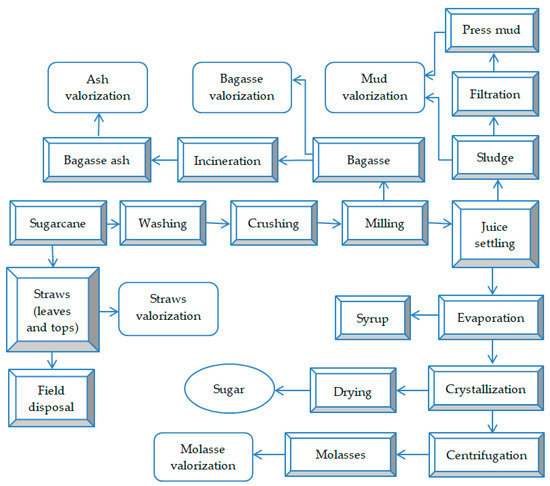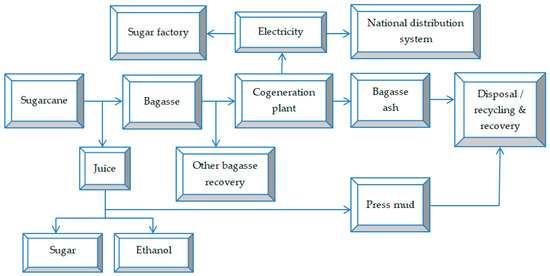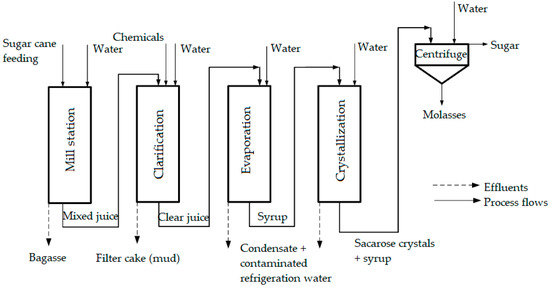Sugarcane is a lignocellulosic crop and the juice extracted from its stalks provides the raw material for 86% of sugar production. Globally, sugarcane processing to obtain sugar and/or ethanol generates more than 279 million tons of solid and liquid waste annually, as well as by-products; namely, straws, bagasse, press mud, wastewater, ash from bagasse incineration, vinasse from ethanol distillation, and molasses. If not properly managed, this waste will pose risks to both environmental factors and human health. Lately, valorization of waste has gained momentum, having an important contribution to the fulfillment of policies and objectives related to sustainable development and circular bioeconomy. Various technologies are well-established and implemented for the valorization of waste and by-products from sugarcane processing, while other innovative technologies are still in the research and development stage, with encouraging prospects.
- biomass
- pretreatment
- cogeneration
- bioethanol
- bio-hydrogen
- compost
- fertilizer
- wastewater
1. Introduction
2. Waste and By-Products Generated in Sugarcane Processing
2.1. Waste and By-Product Generation Flow in Sugarcane Processing Factories
In any sector of the food industry, food production is carried out with significant energy consumption, and relatively large amounts of waste result from the technological processes. Thus, major issues related to food technologies are energy and waste management. In the sugar industry, approximately 279 million metric tons of sugarcane waste are generated annually worldwide [20]. From the global amount of sugarcane waste, South Africa has an annual share of over 1.353 million metric tons, of which more than 50% are recovered in cogeneration facilities [21]. The uncontrolled disposal of sugarcane waste can generate major problems on the environmental factors and, by consequence, on human health. These wastes are of a solid, semi-solid, and liquid nature and can be classified into two categories: waste from the harvesting operation, represented by leaves and cane tips; and waste from the cane processing stream (Figure 2), including bagasse, ash from bagasse incineration, press mud (sludge from juice settling and residual cake from juice filtration), wastewater, vinasse, and molasses.
2.2. Sugarcane Leaves and Tops (Straws)
Sugarcane leaves and tops (also called straws or sugarcane litter) are lignocellulosic materials whose chemical composition varies depending on the stage of development and variety of the plant, place of collection, and climatic conditions. According to [25], these wastes have an approximate composition of 40% cellulose, 25% hemicellulose, and 18–20% lignin. From one ton of sugarcane, between 270–280 kg of leaves and tops remain as harvesting waste [23,26]. Sugarcane straws can contain up to 5% m/m impurities (sand and other debris) due to transport and harvesting operations [27]. If these impurities would reach the cane processing plant, they would cause wear of the mill rolls [28]. Many times, these wastes are conventionally disposed by direct burning in the field [23,29]. Moreover, when traditional manual harvesting is used, farmers set fire to the sugarcane plantations before harvesting to burn off the sharp leaves and facilitate the manual cutting of the stalks. This practice contributes to severe air pollution with suspended particles, the occurrence of severe respiratory diseases in the affected area, and greenhouse gas emissions. In addition, polycyclic aromatic hydrocarbons formed during incineration will pollute both the soil and water. The valorization of cane leaves and tips is practiced on some plantations. If the sugarcane crop is harvested while it is still green, the cane leaves and tips are left as such in the field as a vegetable mulch, to control weeds, reduce water evaporation from the soil, and return carbon and nutrients to the soil [6], thus contributing to the improvement of soil properties [30]. This waste can also be collected manually or mechanically and briquetted or pelletized for incineration for energy purposes [31]. In laboratory experiments, second-generation ethanol with a yield of 156 L/t was obtained from cellulose and hemicellulose mixtures extracted from sugarcane tops and leaves, thermochemically treated by alkaline catalysis, and subjected to simultaneous saccharification and fermentation [6].2.3. Sugarcane Bagasse
2.3.1. Characterization of Sugarcane Bagasse
Bagasse is the primary industrial fibrous residue obtained after pressing (crushing) of sugarcane stalks in order to extract the juice. When processing one ton of sugarcane, between 0.25–0.30 tons of bagasse are obtained [32]. In factories in Brazil, 0.28 tons of bagasse are typically generated [33]. According to other studies, 0.14 tons of bagasse (dry mass) and 0.14 tons of straw (stems) are obtained from one ton of sugarcane [13,23]. It is also estimated that over 700 million tons of bagasse are produced annually worldwide [34], i.e., between 40–50% of the total weight of sugarcane produced annually in the world [35]. In only the top ten countries in terms of sugarcane production, more than 540 million tons of bagasse are generated annually [36]. The chemical composition of sugarcane bagasse varies with plant variety, cultivation conditions, harvesting practices, and processing methods. Sugarcane bagasse contains 45–50% water, 2–5% dissolved sugars and 40–45% fiber [37], and 60–80% carbohydrates [38]. Like any natural vegetable fiber, sugarcane bagasse has a fibrous structure consisting of cellulose, hemicellulose, and lignin [39], with different values of these components being presented in the literature.2.3.2. Uncontrolled Disposal of Sugarcane Bagasse
A significant amount of bagasse is disposed of uncontrollably in the form of waste piles directly on open land [53], which inevitably leads to environmental pollution due to the release of unpleasant odors that attract insects and other pests, and sometimes due to accidental occurrence of self-igniting fires. Even the temporary storage of excess bagasse remaining on the technological flow, which can represent up to 50% of the bagasse produced in the sugar factory [54], has negative consequences on the environment. Uncontrolled disposal and landfills are the most unsustainable option for managing sugarcane wastes.2.3.3. Valorization of Sugarcane Bagasse
In large sugarcane-growing countries, bagasse is an important type of waste that can be recovered [55], and there are currently more than 40 different uses for it [56]. Approximately 58–76% of the wet mass of bagasse is composed of polysaccharides that can be hydrolyzed into monosaccharides (glucose and xylose) and then transformed by microbial fermentation into biofuels, enzymes, proteins, lipids, feed, and other biochemical substances [57].Incineration of Sugarcane Bagasse for Energy Recovery
Sugarcane bagasse with a moisture content of approximately 48% has a calorific value of 8021 kJ/kg [58] and is usually valorized as fuel in cogeneration plants to produce thermal energy (steam) and electricity [59,60]. These energy products can provide the necessary thermal and electrical energy for the operation of the sugar factory [61,62], and the eventual energy surplus is transferred to the national electrical network [63,64]. For example, India annually generates between 75–90 million tons of bagasse (wet mass) [65], which it mainly uses through incineration with cogeneration (electricity and heat generation) in medium and large sugar factories. In Brazil, the energy recovery of one ton of bagasse generates 12 kWh of electrical energy, 330 kWh of thermal energy (steam), and 16 kWh of mechanical energy [66]. In sugar mills, thermal energy and mechanical energy obtained by bagasse incineration are used to drive milling equipment, and electrical energy is used to drive rotating equipment in the factory during the harvest season [8]. Bagasse incineration is, however, associated with large volumes of CO2 emissions that contribute significantly to the global warming faced by all of humanity today [33,67].2.4. Residual Ash from Bagasse Incineration
2.4.1. Characterization of Sugarcane Bagasse Ash
Figure 5 shows a simplified production flow in the sugar factory. After extracting the sugary juice from the sugarcane, the sugarcane bagasse remains as waste. Bagasse represents approximately 50% of the composition of the sugarcane and is, in most factories, incinerated for energy purposes. After its incineration, bagasse ash (consisting of fly ash and bottom ash) will remain as the final waste from the sugar production stream [150].
2.4.2. Valorization of Sugarcane Bagasse Ash
The utilization of bagasse ash can be achieved, at the present time, through different possibilities. Bagasse ash can be applied as an amendment for agricultural land [25], although it does not contain a sufficient concentration of mineral nutrients and will therefore be a fertilizer with low nutritional value. To increase its nutrient content, ash can be mixed with sludge from cane juice filtration or vinasse from ethanol distillation. Another problem related to the utilization of ash as fertilizer in agriculture is its content of heavy metals (aluminum, chromium, lead) and total phenol, whose values exceed the levels allowed by many national standards [151,153]. These chemical pollutants accumulate in the soil (from where they are transferred to the food chain) and can also pollute groundwater, thus triggering potentially serious problems from an agronomic, environmental, and human health point of view. Solid fuels were obtained by briquetting bagasse ash [150,160,161] in the presence of binders or additives. The additives also come from biomass waste or ecological materials, so the use of these solid biofuels contributes to reducing the carbon footprint and protecting the environment. The briquettes obtained in study [150] were starch, obtained from flour of tropical root cassava used as a binder, and presented good mechanical and thermal properties, having an average density of 1.12 g/cm3 and an average calorific value of 25.551 kJ/kg. By carbonizing sugarcane bagasse, ecological coal was obtained which was then added with clay and sugarcane molasses to obtain ecological briquettes for household use, whose combustion does not generate smoke and unpleasant odor, with the following characteristics: 36.4% ash content, 27.2% volatile matter, and 4.390 Kca/g calorific energy [160]. In a study [161], a mixture of bagasse with kraft lignin was briquetted at a temperature of 140 °C and a pressure of 17 MPa for 8 min. It was shown that the addition of kraft lignin improved the characteristics of the briquettes, such as resistance and durability. These characteristics are especially important during the storage and transport of operations because briquettes with low durability crumble easily, generating dust that affects human health; additionally, they can self-ignite if they are stored at high temperatures or they can absorb moisture, which will decrease their calorific value. In the construction materials industry, bagasse is used as a substitute for sand [151], and additive in the manufacturing of bricks [162], cement [62,127,163], mortar, and concrete [123,164,165]. Cement-based materials in which bagasse ash have been incorporated have superior mechanical performance [166]. In addition, this type of ash utilization can help reduce greenhouse gases produced in cement factories, as it is known that the cement industry contributes 8% to the total CO2 emissions from anthropogenic sources [167]. In addition, utilization of bagasse ash in the cement industry decreases the costs of construction materials, alleviates the pressure of the final disposal of waste (storage costs are increasing), and prevents soil and air pollution.2.5. Vinasse from Ethanol Distillation
2.5.1. Characterization of Sugarcane Vinasse
From the ethanol distillation stage, vinasse results as waste, i.e., the fermented liquid medium without ethanol content, considered to be a severe environmental pollutant. Vinasse represents a flow of acidic wastewater (with pH = 3.5–5), dark brown in color, with an unpleasant odor [170], a high chemical oxygen demand (COD), and high salt content [171]; it also contains suspended organic solids, minerals, yeast, sugarcane proteins, and phenolic structures [172]; it has high concentrations of nutrients (nitrogen, phosphorus, potassium) [173,174], heavy metals (zinc, copper, barium, and chromium) [175], residual sugar, and some volatile compounds. For each liter of ethanol produced from sugarcane, between 10–15 L of vinasse are generated [175]. It is estimated that by 2024 the production of vinasse will reach 1742 billion liters [171].2.5.2. Valorization of Sugarcane Vinasse
Due to its large generation volumes and still limited fields of application, vinasse is successfully treated mainly by anaerobic digestion [173,176,177]. Anaerobic digestion of vinasse contributes to the reduction of pollution because its polluting load with organic compounds is considerably reduced by biological treatment, and the obtained biogas is a renewable biofuel. Due to the high concentration of sulfides in the vinasse, the biogas obtained will also have high concentrations of hydrogen sulfide, a highly corrosive gas that, if not removed quickly, will attack the pipes of the installations. Technologies for obtaining third-generation biodiesel and hydrogen from vinasse are currently in the development stage [178]. Because of the low concentration of fermentable carbon in vinasse, it can be mixed with carbohydrate sources (such as molasses) to allow the production of larger amounts of hydrogen. The vinasse can also be temporarily stored in lagoons where treatment by oxidation takes place under natural conditions, to be later applied as liquid organo-mineral fertilizer [174,179,180], by sprinkling systems, on the sugarcane fields in the vicinity of the ethanol distilleries, thus contributing to higher agricultural productions. The phosphorus content of vinasse can fully cover the requirements of agricultural crops. Like any other type of fertilizer, it must be mentioned that the application of vinasse must be done at the times and rates required by the characteristics of the crop and the soil. If applied in excess, it will lead to reduced productivity and late maturation of the sugarcane crops, which will have a low sucrose content; additionally, excess vinasse causes environmental problems such as soil pollution with heavy metals, soil acidification and salinization, processes that disturb the soil biota, and salt leaching to groundwater. On a laboratory scale, due to its high content of micronutrients, vinasse was used as a growth medium for filamentous fungus Neurospora intermedia, and as a substrate for obtaining unicellular products (proteins, lipids, enzymes, organic acids, alcohols). The obtained biomass contained 45% protein and important essential amino acids [181].2.6. Press Mud (Cake)
2.6.1. Characterization of Sugarcane Press Mud
Press mud (cake) is the dark, spongy solid residue left after the juice extracted from sugarcane has been clarified and filtered. Processing one ton of cane yields 0.03 tons of press mud [182], which is rich in fiber, crude protein, crude wax, sugar, fat, and ash Therefore, press mud has a complex composition: 15–30% fibers, 5–15% crude proteins, 5–15% sugars, 5–14% crude wax, 9–10% total ash, 4–10% SiO, 1–4% CaO, 1–3% PO, and 0.5–1.5% MgO [183]. Press mud is an insoluble material, whose decomposition in natural conditions takes a long time, generates an acid leachate [184], emits unpleasant odors that attract insects and other pests, but also intense heat [185] and poses risks of self-ignition [184] when exposed to direct sunlight.2.6.2. Valorization of Sugarcane Press Mud
Being a waste rich in nitrogen, phosphorus, calcium, and organic matter [186], press sludge can be used as soil fertilizer [187,188]. Its usefulness in reducing soil degradation through crusting, cracking, erosion, and compaction has been demonstrated [28]. Press sludge can be composted as such [189] or mixed with wastewater or residual vinasse from ethanol distillation [190], with animal manure and bagasse [25], or with other types of vegetable waste [191]. It can also be vermicomposted [53], in the presence of earthworm species such as Eisenia fetida or Eudrillus eugeniae. A drawback of composting is that it is a slow process that requires large spaces and infrastructure for turning, aeration, and watering the furrows or piles of organic matter. On the other hand, excessive application of press sludge to the field for long periods will result in soil contamination, due to accumulation of heavy metals (zinc, copper, lead) [22,192], and in negative effects on plant growth [193]. Other domains in which press sludge is used include aquaculture [194]; biosorbent for some metal ions and dyes from liquid solutions [195]; the production of hydrocarbons and chemicals [196]; the production of cement, paints, and foaming agents [182]; the production of biofuels, such as ethanol, biobutanol, and biogas [22] and of biofuel briquettes obtained from cane straws, bagasse, bagasse ash, and press sludge [197].2.7. Wastewater from Sugarcane Processing
2.7.1. Characterization of Wastewater from Sugarcane Processing
Wastewater represents the most common waste of the food industry, and in most of the unitary operations of food product technologies taking place in an aqueous environment or requiring significant amounts of fresh water. The sugar industry is one of the main users of fresh water at all stages of the technological stream, and consequently among the largest generators of wastewater. In sugarcane factories (mills), wastewater is mainly generated from the washing operations of floors and equipment on the process stream, in evaporators (condensate water), by cane juice leaks at improperly attached taps of pipelines, from syrup and molasses generation stages, and from dewatering of press mud or of other solid waste [198] (Figure 6).
